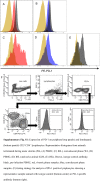Changes in immune cell populations in the periphery and liver of GBV-B-infected and convalescent tamarins (Saguinus labiatus)
- PMID: 24246306
- PMCID: PMC3969288
- DOI: 10.1016/j.virusres.2013.11.006
Changes in immune cell populations in the periphery and liver of GBV-B-infected and convalescent tamarins (Saguinus labiatus)
Abstract
Flaviviruses related to hepatitis C virus (HCV) in suitable animal models may provide further insight into the role that cellular immunity contributes to spontaneous clearance of HCV. We characterised changes in lymphocyte populations in tamarins with an acute GBV-B infection, a hepatitis virus of the flaviviridae. Major immune cell populations were monitored in peripheral and intra-hepatic lymphocytes at high viraemia or following a period when peripheral virus was no longer detected. Limited changes in major lymphocyte populations were apparent during high viraemia; however, the proportions of CD3(+) lymphocytes decreased and CD20(+) lymphocytes increased once peripheral viraemia became undetectable. Intrahepatic lymphocyte populations increased at both time points post-infection. Distinct expression patterns of PD-1, a marker of T-cell activation, were observed on peripheral and hepatic lymphocytes; notably there was elevated PD-1 expression on hepatic CD4(+) T-cells during high viraemia, suggesting an activated phenotype, which decreased following clearance of peripheral viraemia. At times when peripheral vRNA was not detected, suggesting viral clearance, we were able to readily detect GBV-B RNA in the liver, indicative of long-term virus replication. This study is the first description of changes in lymphocyte populations during GBV-B infection of tamarins and provides a foundation for more detailed investigations of the responses that contribute to the control of GBV-B infection.
Keywords: 4-(2-hydroxyethyl)-1-piperazineethanesulfonic acid; APC; Acute viral hepatitis; CTLA4; DMSO; EGTA; FITC; Fluorescein isothiocyanate; GB virus B; GBV-B; HBSS; HCV; HEPES; Hank's balanced salt solution; IFN; IHL; IVT; Immune cell; MFI; MHC; NK; NS; PD-1; PD1-L1; PE; RPMI; Roswell Park Memorial Institute medium; allophycocyanin; cytotoxic T lymphocyte antigen-4; dimethyl sulphoxide; ethylene glycol tetraacetic acid; ge; genome equivalents; hepatitis C virus; in vitro transcription; interferon; intrahepatic lymphocytes; major histocompatibility complex; median fluorescence intensity; natural killer; non-structural; phycoerythrin; programmed death receptor-1; programmed death receptor-1 ligand; qRT-PCR; quantitative reverse transcriptase polymerase chain reaction; vRNA; viral ribonucleic acid.
Crown Copyright © 2013. Published by Elsevier B.V. All rights reserved.
Figures






Similar articles
-
Immunity against the GBV-B hepatitis virus in tamarins can prevent productive infection following rechallenge and is long-lived.J Med Virol. 2008 Jan;80(1):87-94. doi: 10.1002/jmv.21013. J Med Virol. 2008. PMID: 18041000
-
Characterisation of Mhc class I and class II DRB polymorphism in red-bellied tamarins (Saguinus labiatus).Immunogenetics. 2011 Oct;63(10):619-26. doi: 10.1007/s00251-011-0546-4. Epub 2011 Jun 17. Immunogenetics. 2011. PMID: 21681586
-
Chronic hepatitis associated with GB virus B persistence in a tamarin after intrahepatic inoculation of synthetic viral RNA.Proc Natl Acad Sci U S A. 2003 Aug 19;100(17):9962-7. doi: 10.1073/pnas.1731505100. Epub 2003 Aug 7. Proc Natl Acad Sci U S A. 2003. PMID: 12907703 Free PMC article.
-
GB virus B as a model for hepatitis C virus.ILAR J. 2001;42(2):152-60. doi: 10.1093/ilar.42.2.152. ILAR J. 2001. PMID: 11406717 Review.
-
The GB viruses: a review and proposed classification of GBV-A, GBV-C (HGV), and GBV-D in genus Pegivirus within the family Flaviviridae.J Gen Virol. 2011 Feb;92(Pt 2):233-46. doi: 10.1099/vir.0.027490-0. Epub 2010 Nov 17. J Gen Virol. 2011. PMID: 21084497 Free PMC article. Review.
Cited by
-
High susceptibility, viral dynamics and persistence of South American Zika virus in New World monkey species.Sci Rep. 2019 Oct 10;9(1):14495. doi: 10.1038/s41598-019-50918-2. Sci Rep. 2019. PMID: 31601848 Free PMC article.
-
The Impact and Effects of Host Immunogenetics on Infectious Disease Studies Using Non-Human Primates in Biomedical Research.Microorganisms. 2024 Jan 12;12(1):155. doi: 10.3390/microorganisms12010155. Microorganisms. 2024. PMID: 38257982 Free PMC article. Review.
References
-
- Barber D.L., Wherry E.J., Masopust D., Zhu B., Allison J.P., Sharpe A.H., Freeman G.J., Ahmed R. Restoring function in exhausted CD8T cells during chronic viral infection. Nature. 2006;439:682–687. - PubMed
-
- Beames B., Chavez D., Lanford R.E. GB virus B as a model for hepatitis C virus. ILAR J. 2001;42:152–160. - PubMed
-
- Bowen D.G., Walker C.M. Adaptive immune responses in acute and chronic hepatitis C virus infection. Nature. 2005;436:946–952. - PubMed
Publication types
MeSH terms
Grants and funding
LinkOut - more resources
Full Text Sources
Other Literature Sources
Research Materials
Miscellaneous

